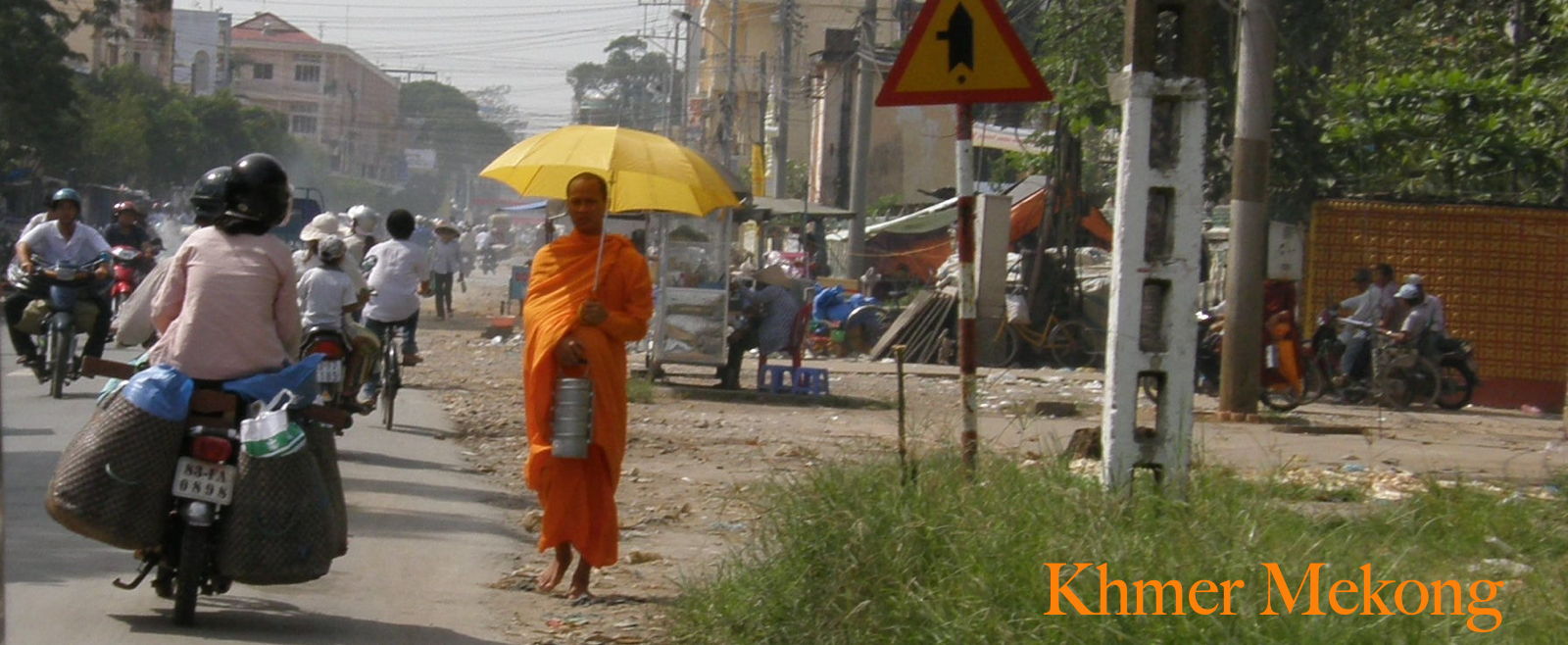KHMER MEKONG
Locating the Khmer • Sóc Trăng • 2007 protest • Ok Om Bok • Travels in Trà Vinh • Vietnamese Temple to Thach Dul • The Khmer in the Far West • Taylor’s “Khmer Lands of the Mekong” • Mounds: New Year 2022
The Mekong was terra incognito to me during my early years in Saigon (1958-1964). In that span, my family traveled to Dà Lạt, Vũng Tàu, and (I think) Tây Ninh, but only my father went down to the delta. (He was assisting the Ministry of Education in setting up vocational training programs.)
I didn’t make contact with the Delta until 2000, when I joined a biking tour from Saigon to Cần Thơ (the actual starting point, I think, was Mỹ Tho). The scenery was quite different than that in the north and the center of Vietnam—no karst formations, no ancient temples, no Cham towers. The terrain was flat and the sight lines limited. And yet these backroads were almost idyllic, shaded lanes occasionally opening into rice fields, with villages that consisted of little more than a string of houses fronting the asphalt thoroughfare.
When we came to the main branches of the Mekong, we traversed them on ferries—hulking diesel giants from Eastern Europe—because none of the modern bridges had been completed yet. (The first of these, the Mỹ Thuận bridge over to Vĩnh Long, had not been finished at the time.)
It was only later that I realized that we hadn’t seen any Khmer villages or temples in the course of this trip. As I became more familiar with the region, it occurred to me that our tour itinerary had followed the arc of Vietnamese settlement in the delta, moving up the eastern branch of the Mekong from Mỹ Tho, crossing over to Vĩnh Long and heading southwest towards Cần Thơ. There are still some Khmer communities in this stretch, to be sure, but they are mostly off the beaten track.
It wasn’t until four years later that I was properly introduced to Khmer culture. By this time, I was making up my own itineraries, going to see particular places that I had read about. I had made friends with a businessman who was from the delta, and he volunteered to come along for the ride. He was determined to show me the nitty-gritty of how people in the Mekong really lived; I tried to explain that I was mainly interested in the doings of people who were long dead. It made for an oddball kind of tour, but we each got a full share of what we were after.
A Few Notes on Khmer Temples
Khmer Buddhist temples (wats) are found scattered through most of the Mekong region and on the southwestern coast, but they predominate in the two provinces that have retained Khmer names: Sóc Trăng and Trà Vinh. The government counts over 140 temples in Trà Vinh and some 99 in Sóc Trăng.
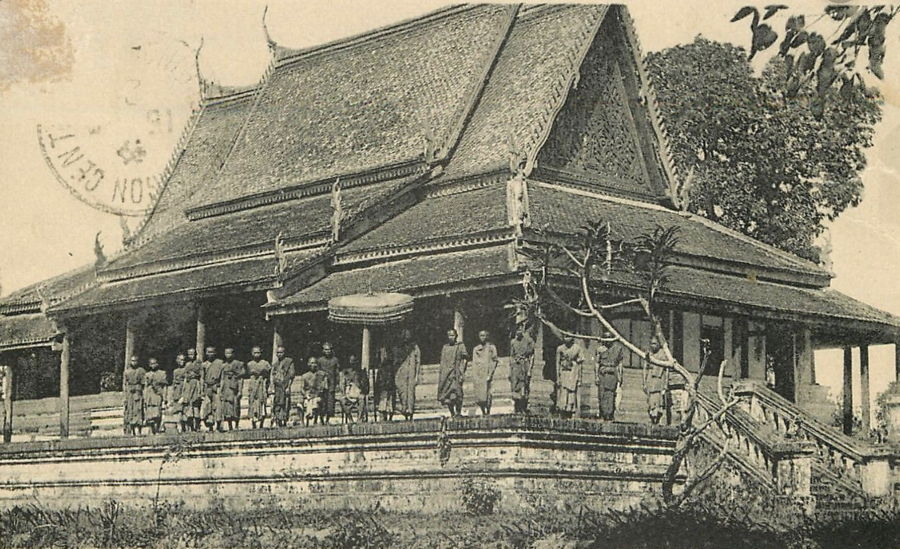
Early 20th century French postcard of a Khmer wat in Sóc Trăng.
Of course, these Khmer temples bear no resemblance to the great stone ruins of Angkor Wat. That is to say, they are not grandiose monuments constructed at great cost to exalt divinely-anointed kings, but community temples in a distinct style that is common to Cambodia, Laos, and Thailand. Serving both educational and religious purposes and deeply integrated into village life, the temples reflect the admirable communal and egalitarian aspects of Theravada Buddhism. (Though it must be noted that the monastic tradition excludes women.)

Typically, the worshipping hall has a single altar to the Buddha, while the walls are painted with scenes from the Buddha’s life.
Picture from Wat Cham Pa Botray, Nguyễn Phương Trúc Vũ, April 2022.
Unlike the Mahayana temples of the Chinese and Vietnamese, there is but one altar, at one end of the main hall. In contrast to this simplicity, the halls are adorned with colorful mural scenes from the life of the Buddha, with the varying styles depending on the date they were painted or repainted. (Sometimes the corners of one of these paintings will have a note acknowledging the donor who contributed to it.)
While the sole deity to be worshipped is the Buddha, there are many ancillary spirit-figures, many of whom are identified in the following entries.
Sóc Trăng (Srok Khleang)
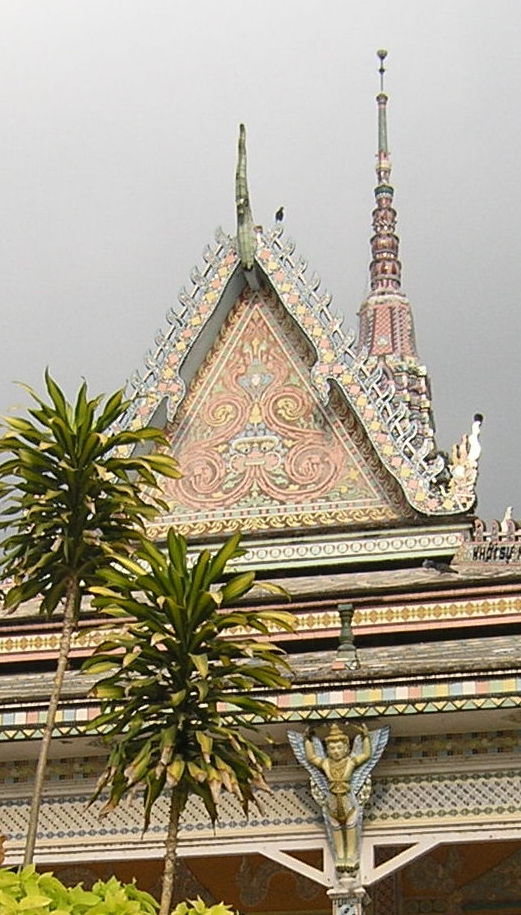
The first stop on my first trip to Sóc Trăng was the Wat Sro Loun just outside of town. The Vietnamese familiarly call Chùa Chén Kiểu (Bowl-Style Pagoda), because its walls are adorned with broken ceramics, something you’re more apt to find in the royal citadel of Huế.
We were greeted by the venerable head monk, who seemed very happy to meet us. He grasped my arm firmly and held it for a while, in no hurry to let it go. We were told that the temple was founded some 250 years ago, but it had been destroyed by bombing during the American war. I was a little shy at the outset, and did not ask the obvious questions: did the Việt Công use the temple as a staging point during the Tết offensive? Was the temple completely destroyed? (I saw no signs of bomb craters, suggesting that it might have been damaged by artillery or small arms fire, rather than obliterated.)
While the Wat Sro Loun is a local landmark, the Wat Maha Tup in Sóc Trăng has a much wider regional reputation because of the population of large bats that can be seen hanging in the surrounding trees. (The Vietnamese call it Chùa Dơi, the “Bat Pagoda.”) Like several other Khmer pagodas, it has become an unofficial wildlife sanctuary. This closeness to nature is, in fact, a part of the special charm of Khmer communities and temples.
The provincial museum in downtown Sóc Trăng has a small but interesting collection of Khmer artifacts. Unfortunately, the small cards next to the exhibits reveal almost nothing about the significance of the items, or their dating and provenance. Nor is it easy to figure out the times when the museum is open. Remarkably, despite the marketing of Khmer culture for purposes of tourism, the provincial government has shown little or no interest in upgrading the exhibits or staffing the museum.
The Wat Kh’leang is right across the street from the museum, and is the largest and most prestigious in the province. It is an urban teaching temple, and the main worshipping hall is not always open. But there have been occasions when we were able to go in and see its eclectic holdings. One interesting decorative feature is its black columns decorated with golden carp. The style of these fish is more Chinese than Khmer, which made me wonder as to the source—possibly a Thai influence, or perhaps from the neighboring province of Bạc Liêu, where the Teochew and Khmer are especially close.
Or perhaps the Chinese influence is to be found in Sóc Trăng itself, for one day I stumbled across several classic Chinese temples in the downtown area, with altars to such familiar figures as Bắc Đế (Shenwu), Ông Bổn (Dabu Gong), and Quan Đế (Guandi). In fact, as I was to discover, there were Chinese merchant centers in nearly every Delta town, forming a complex network that, among other things, shipped the vast rice surpluses of the region up to Saigon.
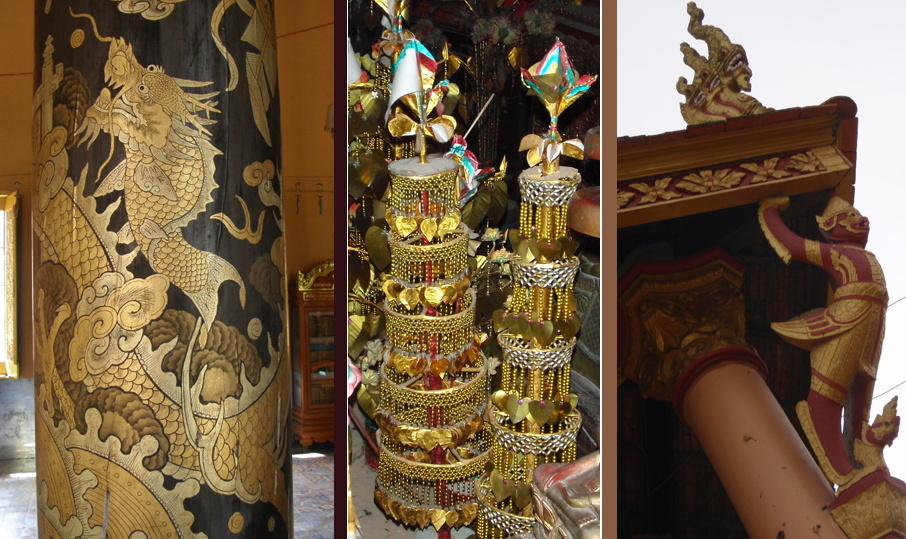
Some of the decorative elements of a Khmer temple, as seen at the Wat Kh’leang: internal columns, votive gold trees, and the krud (garuda-bird) and naga-dragon roof ornaments
Travels in Trà Vinh (Preah Trepeang)
Initially, I did not find the temples of Trà Vinh as interesting as those of Sóc Trăng, but that has changed over the years. The best starting point is the site at Bà Om Pond (Ku Srah Srey, “the women’s pond”), which includes the Wat Angkorajaborey (Chùa Âng) and a museum of Khmer culture, the latter housed in an airy modern building.
I have to admit that when I first visited the famous Wat Angkorajaborey (Chùa Âng) on the outskirts of Trà Vinh, I was puzzled by the reputation of the pond, touted by tour sites as a “must-see” attraction. What charm could we see in a rather ordinary basin of water? In retrospect, I have to admit that this was the blinkered view of a suburb-dweller, long accustomed to getting water from a tap.
I was, of course, one of those city-dwellers. Growing up, my dry seasons had been spent in an apartment in downtown Saigon, and I had never seen the water ebbing away all through the hot, cloudless months from January to April. I began to appreciate its qualities later, after reading Philip Taylor’s Khmer Lands. Now I have a pleasant memory of that special basin, ringed by trees whose trunks rise from gargantuan above-ground roots.
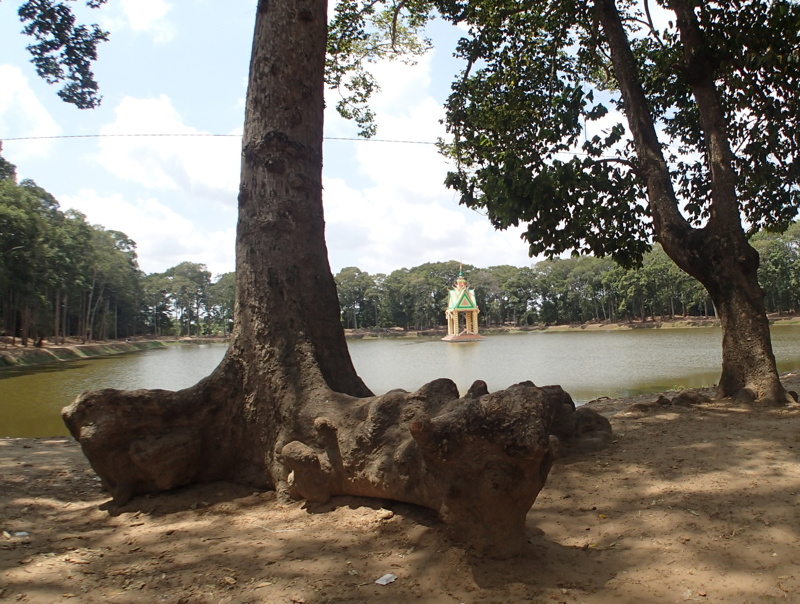
The Ba Om pond at the Wat Angkorajaborey.
The Wat Angkorajaborey (sometimes “Angarrajapuri”) has always been vacant when I’ve visited—I don’t know if it is used on a regular basis by the resident monks or if it is considered more of a public space for visitors. It is a handsome building, said to have been erected in 1842, though the arched colonnade certainly came later. I was struck by two of its murals back when I visited in 2005. In one, a bored-looking man in a blue uniform (a Vietnamese colonial official?) lounged in a chair, accompanied by an elegantly dressed woman. A group of bare-chested Indians were pointing up at an apparition of the Buddha floating in air—the official seemed to be looking that way, but not his companion. I’ve seen murals in other Khmer temples that similarly hint at the curious aspects of the colonial-era recognition of minority traditions.
The other mural that caught my eye showed a sinking ship surrounded by people struggling in the surrounding ocean, which was populated by crocodilean monsters. A deity flew overhead, in the fashion of the Chinese goddess Thiên Hậu, while a small plane (single propellor) was passing in the distance. I could not tell if this was a reference to a specific disaster—the date painted on its stern, possibly 1938, seemed significant. I made a point of searching this mural out several years later, but found that the scene had been repainted, and the airplane, the lettering, and other crucial details had vanished.
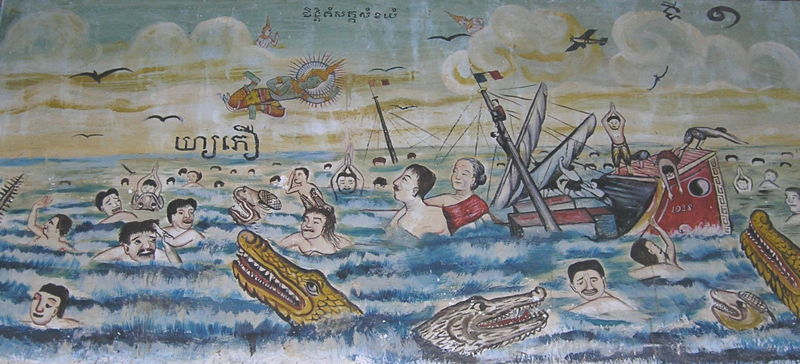
THE MUSEUM. The first time I visited the adjacent museum with friends, we were given a very interesting tour of the exhibits by a woman who used to be a member of the traditional Khmer dance troupe from the area. I said I'd love to see a performance, and mentioned to my friend (a tour operator) that a lot of other tourists would be interested as well. Alas, this idea proved to be naïve and ill-informed. Public performances of Khmer dance require permission from the provincial government, and it sounded as if any such request would die somewhere in the bureaucracy.
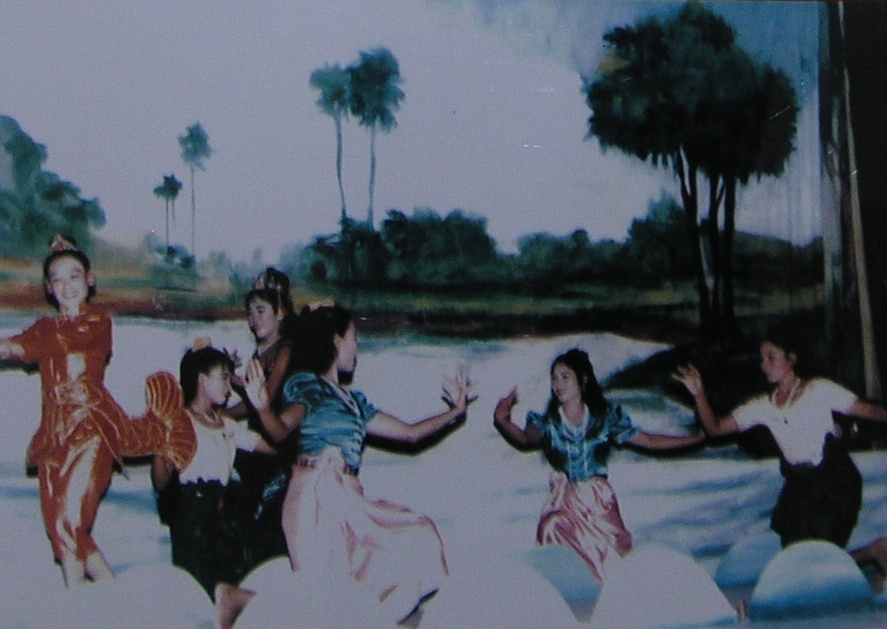
Photograph of Khmer dance performance kept at the Trà Vinh Khmer museum.
In subsequent visits, I found the museum closed, with a sign saying it was “under renovation,” but I saw no signs of construction. “Under renovation” can be a euphemism for all kinds of things, including bureaucratic malfeasance and official indifference, and when I found the museum still “under renovation” a year later, I began to wonder if it had something to do with the recent protests. (Through a well-connected friend, I heard that the police thought the Khmer situation was “as hot as in the Highlands,” which struck me as a preposterous exaggeration of the threat posed by public demonstrations that were being organized by an ethnic minority that had shown little inclination for revolutionary violence.)
And so, this is the frustrating conundrum—despite a great deal of advertising that encourages tourists to come to Trà Vinh, it’s clear that the powers-that-be are bent on limiting any interaction between Khmer people and foreigners.
This was made all the more evident to me in my later travels, when Khmer monks chose their words carefully and spoke in hushed tones about police surveillance. Once, when visiting another wat in Trà Vinh, I asked about the tomb of Son Kui, a revered local leader (oknha) who became involved in a rebellion against Nguyễn policies in the delta and is revered for surrendering (suffering decapitation) to save his people from further bloodshed. The young monk brushed aside my question, remarking with evident bitterness that “we are not allowed to talk about history.”
A Vietnamese Temple to a Khmer Commander
A neglected aspect of the Khmer story in the Mekong is how local leaders reacted to the step-by-step annexation of the region by the Nguyễn lords (whose royal center was near present-day Huế on the central coast). As with the westward movement of settlement in North America, this was a complex process, involving many parties with diverse interests. The vanguard was made up of Chinese traders and refugees, along with ethnic Vietnamese migrating from the central coast, and even Cham and Lao warlords play a role in the chronicles of this time. As in the North American case, there were occasional clashes spurred by different factions on both sides—but there were also alliances and accommodations between natives and the newcomers.
On the outskirts of the trading town of Trà Ôn, for instance, there is a traditional Sino-Vietnamese temple to Nguyễn Văn Tôn, identified as the commander of the “Forward Army” (Tiền Quân, 前軍) and bearing the unusual inscription Thống chế Điều bát (統制調撥). Upon further inspection, it turns out that these titles refer to a Khmer leader named Thach Dul who allied himself with the exiled prince Nguyễn Ánh in the early 1780s.
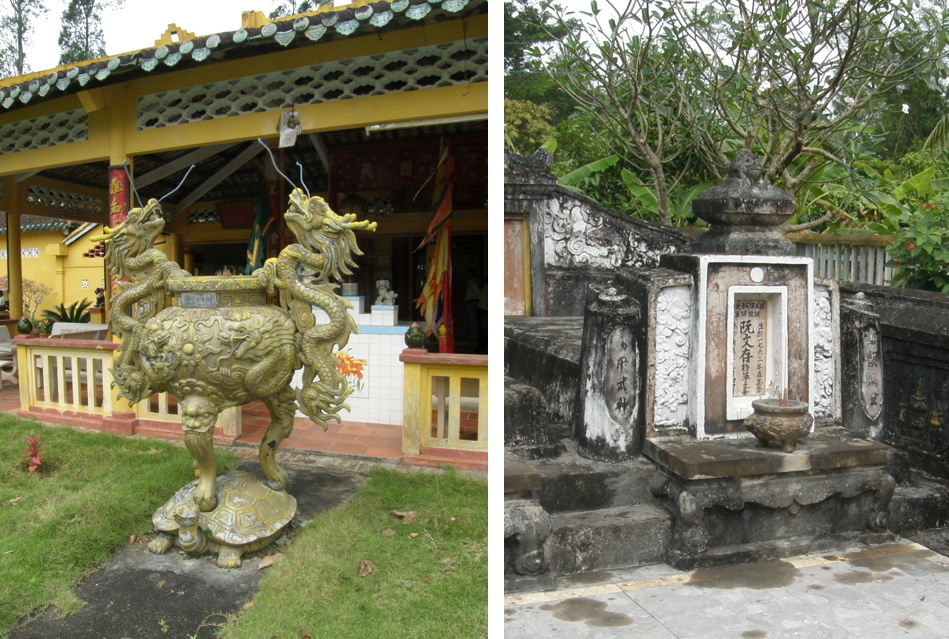
The temple to Nguyễn Văn Tôn faithfully follows the Sino-Vietnamese style, with a worshipping hall and an adjacent tomb courtyard.
He took it upon himself to recruit a contingent of Khmer soldiers from the delta, and was also often given charge of Siamese troops sent by King Rama to assist in the campaigns against the Tây Sơn. After the civil war was concluded, he was appointed as official in charge of the Khmer regions of the delta. Much later (1819), he was a deputy in the Vĩnh Tế canal project, working under Thoại Ngọc Hậu (see Châu Đốc). He was a victim of the great cholera epidemic that spread through the camps of the canal laborers, killing hundreds or even thousands.The temple to Nguyễn Văn Tôn faithfully follows the Sino-Vietnamese style, with a worshipping hall and an adjacent tomb courtyard.
Thống chế is an honorific military title that he received in 1811, probably in connection with the Vietnamese intervention in Cambodia at that time. Điều bát appears to be a portion of the title he was given as commissioner in charge of the Khmer workforce on the Vĩnh Tế canal.
At first, I wondered if the Vietnamese of Trà Ôn had adopted Marshal Tồn as a protective spirit. Perhaps he was even that mysterious thành hoàng worshipped in the village định near the riverfront? However, this was probably not the case. To be sure, the Nguyễn emperor Minh Mạng is said to have provided for his funeral and supplied a sắc tứ recognizing the spirit of Tồn. It is said that a tomb was constructed at that time, but was it in the Vietnamese style— Or were his ashes interred in a stupa?
There’s no certainty in the matter, but it seems likely that Tồn never fully adopted Vietnamese custom. His family is said to have fallen into disfavor after Tồn’s son was accused of participating in the Lê Văn Khôi rebellion (1833-1835). The Khmer uprising may not have been coordinated with Khôi’s, but the Khmer had their own grievances over Minh Mạng’s overbearing attempts to impose strict administrative and cultural conformity upon the south.
As for the present-day memorial temple, it was the idea of a local Chinese association, the Mĩ Thanh Hội Quán. (The name of this association—美清會館—appears on one of the temple’s signboards.) This effort to commemorate Tồn began in 1904, well into the colonial era. The Mĩ Thanh association applied to the royal court in Huế for a new sắc tứ, but this appeal was not heeded until late in the reign of Bảo Đại. In 1996, the temple was also recognized by the Ministry of Culture in a decree that serves as the modern version of the sắc tứ.
The Khmer in the Far West (Miền Tây)
My delta journey in 2007 included a preliminary tour of the "Western Lands," including the cities of Rạch Giá and Hà Tiên. (For convenience, I refer to this region west of the Hậu Giang / Bassac as Miền Tây, the “Western Region,” following Pierre Brocheux and others, though in common usage the term can mean the whole of the Mekong region to the south and west of Saigon.)
I saw that other Khmer temples still dotted the landscape, and had occasion to visit one while making my way down from the town of Hòn Đất, foolishly hoping to find the site of the short-lived Catholic seminary established by the MEP in the 1760s. (The seminary was said to be at Hòn Đất, but the modern-day town seems to be an entirely different place—when we called at the local church, the priest said he was unaware of any such historical site and said he was not familiar with the illustrious Bishop Pigneaux.)
Along the road down the peninsula, we came across a small, simple wat of modern construction (though it did have a version of the overlapping roofs). It did not seem to be well kept up, with trash littering the yard and no sign of an adjoining village. Inside, though, it had an extensive set of wall murals. No one was at hand who could explain them, and so I could only guess at the meaning of some of the more unusual images amongst the panels depicting the life of the Buddha. Contemporary figures with expressions of horror or sorrow, a head with closed eyes looking from the jaws of a crocodile … something to do with the war, or refugees, or the horrors inflicted by the Khmer Rouge across the border?
In 2008, I retraced my route to the western coast. Outside Rạch Giá, I visited the temple known to the Vietnamese as "Great Buddha" (Phật Lớn), but called Wat Uttunmanjeay by the Khmer. The doors were closed, but I did get a glimpse of some of the Tong Krapur—“crocodile flags”—hanging from the rafters. It was only later that I read Elizabeth Guthrie’s marvelous discussion of the mythology of the crocodile in her thesis, A study of the history and cult of the Buddhist Earth Deity in mainland Southeast Asia (available online).
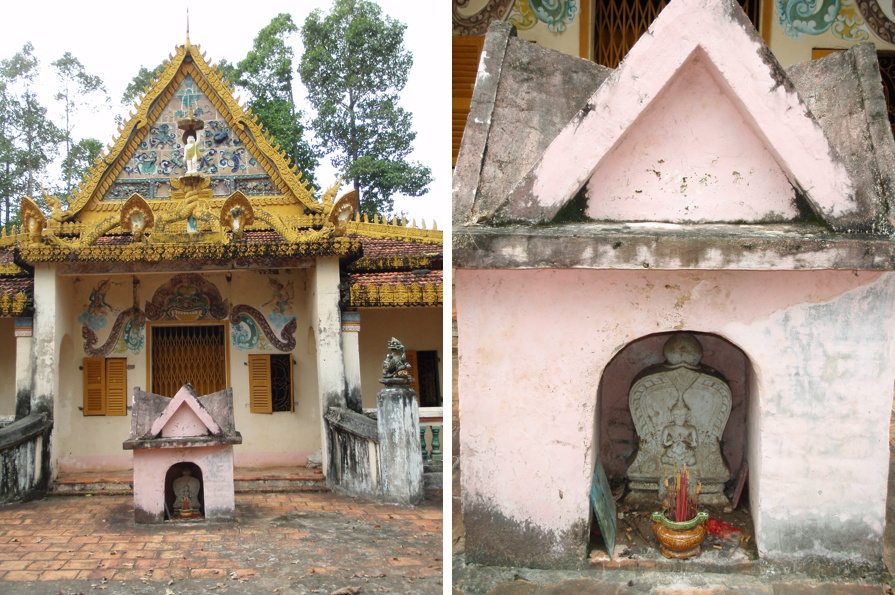
Outside, there were several small shelters housing headstones. Though such shelters are often erected for the neak ta, local protective spirits, in this case the carved headstones were the slik sima, markers of the sacred precinct of the temple. Typically, eight of these are arranged at compass points around the perimeter of the main temple courtyard, with a ninth sometimes placed at the center of the main hall within the temple.
Back out on the main road, we searched out the Khmer potters near the main intersection in Hòn Đất to deliver a few photographs, having been deputized by some ceramics mavens back in the U.S.
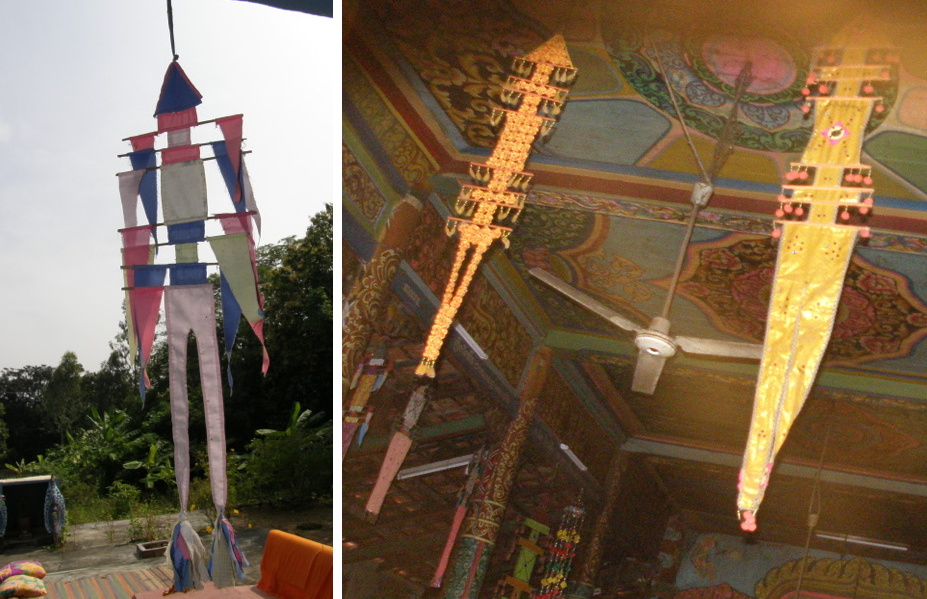
Temple hangings (the tong krapur “crocodile flag”) and a slik sima temple boundary marker at the Wat Uttunmanjeay in the coastal city of Rạch Giá.
“Khmer Lands of Vietnam”
There can be no greater happiness for an area researcher than the appearance of a book that comprehensively addresses a hitherto obscure realm. And so, in 2014, after nearly a decade of collecting dribs and drabs of information about the Khmer culture in the Mekong delta, I was astonished and delighted to find that the National University of Singapore had just released The Khmer Lands of the Mekong, an exceptional study authored by Philip Taylor. Taylor is an anthropologist working at Australian National University who has quietly been charting the social landscape of the Delta—his previous works include Goddess on the Rise, a fascinating study of Vietnamized southern spirits, and Cham Muslims of the Mekong Delta, focusing on the trading culture of the Cham villages near Châu Đốc. The Khmer Lands of Vietnam is a brilliant addition to this series, giving a wide-ranging account of Khmer communities found in varied environmental settings (not just traditional “Khmer” provinces of Sóc Trăng and Trà Vinh).
Timothy Gorman, reviewing the book in Sojourn, gives a concise explanation:
The diversity of environmental conditions in southern Vietnam, Taylor argues, has given rise to regionally distinct ways of life, and there are thus multiple ways of "being Khmer Krom" (p. 266), each specific to a particular sub-region. The organization of the book flows from this premise, with each of its seven chapters surveying one such sub-region and its resident Khmer population, tracing the ways in which environmental conditions shape local livelihoods, identities and social organization.
In the fifth chapter, “Flooded Mountains,” I recognized one of the places I visited in 2009, when I was stopping at a couple of Khmer pottery villages on behalf of a researcher. This was a village nestled upon a fold in the “alluvial apron” at the foot of Núi Cấm (Phnom Polpia). Núi Cấm is one of the “Seven Mountains” (Thất Sơn or Bảy Núi), so called by the Vietnamese, who speak of the region as a land of mystery of spiritual energy. The Khmer have an older memory of the region, and identify twenty different peaks by name, with legends as to their origin and stories of hermits and rebels who lived in their caves and forests.
Throughout, Taylor delves into some of the causes of distrust between the government and the Khmer communities, particularly concerning the traditional role of Buddhist institutions in village life. It is a complex issue, as Taylor relates, involving the standardization of a secular curriculum taught in Vietnamese—sometimes with the assistance of Khmer monks who see the need to prepare Khmer youth to participate in the majority society. (We Americans may find analogous social forces at work in Indian reservation schools, fundamentalist religious academies, and the attempts to establish a nationwide “core curriculum” in public schools, the difference being the considerable legal protection enjoyed by private schools.)
Mounds: Khmer New Year) 2022
For some reason, my trips into the Khmer regions of the Mekong delta have never coincided with the New Year’s festivities (Choul Chnam Thmey, held in the fourth lunar month), which means that I have never had a chance to photograph the sand mounds (phnom khsak) that are typically raised on the grounds of the wat.
So, ironically, I first saw this phenomenon at a Laotian wat not too far from my home in Nokesville, Virginia. The immensity of sand suggests that heavy equipment was used in the project. The beautiful modeling of the cone is something not usually seen in the Khmer delta, at least not in the outdoors.
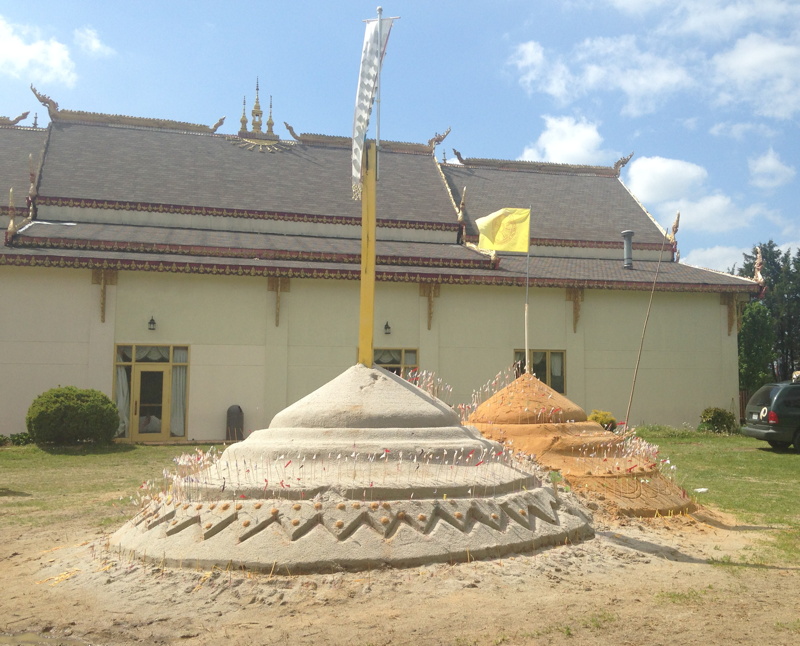
A few years later, the Vietnamese Khmer community began to build its own temple in the area, and they celebrated with their own, rather modest mound, closer to what one sees in the Khmer provinces of the delta.
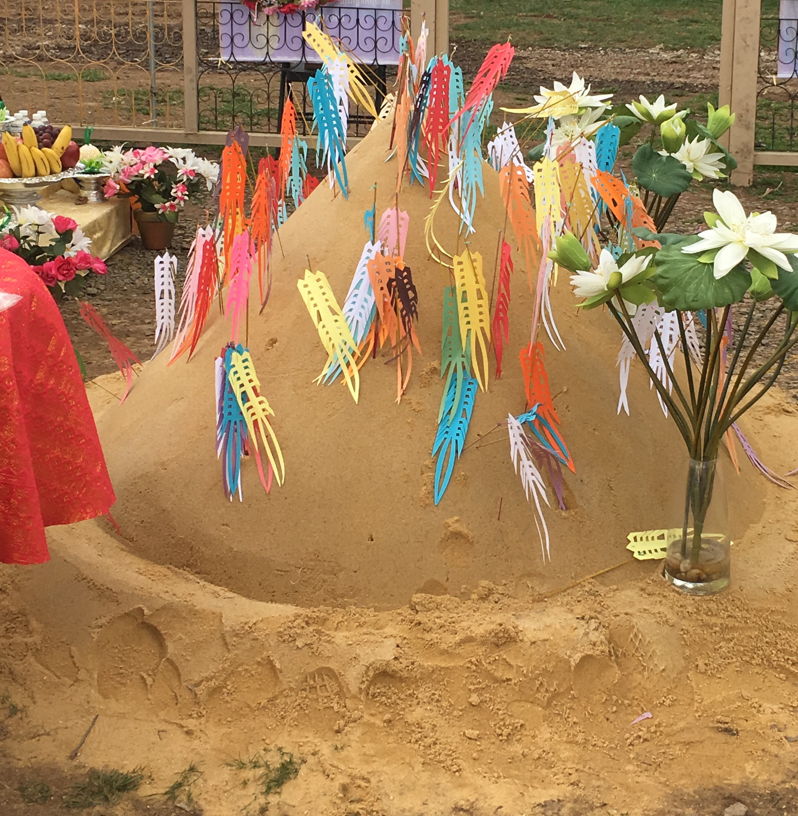
In 2022, one of my collaborators spent the New Year’s season in Trà Vinh and came back with an extensive collection of photographs from a dozen of its Khmer wats. As the rainy season is beginning at this time of year, the small mounds are sometimes covered with banana palm leaves to protect the slopes from being washed away.

Sand mound in the courtyard (Wat Kompong Ksan), and mound under a tent (Wat Kokeosiri), Trà Vinh, April 2022.

tudents playing the gamelan during the festivities at the Wat Cham Pa Botray.
- The Khmer Lands of Vietnam: Environment, Cosmology and Sovereignty, Philip Taylor, Asian Studies Association of Australia: Southeast Asian Publications Series Publication, 2014.
- “Searching for a Khmer Monastic Higher Education in Post-Socialist Vietnam Chapter,” Philip Taylor, Connected and Disconnected in Viet Nam, ANU Press, 2016.
- A Study of the History and Cult of the Buddhist Earth Deity in Mainland Southeast Asia, Elizabeth Guthrie, thesis, University of Canterbury, Christchurch, New Zealand, 2004.
- Vietnamese Studies, Special Issue on the Khmer Culture in the Mekong Delta (Southern Vietnam), New Series No. 27(97), 1990, no. 3.
- Người Khmer ở Nam Bộ, Việt Nam / The Khmer in the South of Vietnam, Vũ Khánh (editor), NXB Thông Tấn, Hà Nội, 2012.
- On the Margins, Rights Abuses of Ethnic Khmer in Vietnam's Mekong Delta, Human Rights Watch, New York, NY, 2009.
- “Reahu, Decorative Symbols in the Khmer Pagodas of Southern Vietnam,” Phan Thi Yen Tuyet in Vietnamese Studies, New Series No. 27(97), 1990.
- Cambodian Buddhism: History and Practice, Ian Harris, University of Hawaii Press, 2008.
- Buddhist Painting in CambodiaVittoria Roveda, River Books, Bangkok, 2009.
- Water Frontier; Commerce and the Chinese in the Lower Mekong Region, 1750-1880. This collection of scholarly essays, edited by Li Tana and Nola Cooke, explores the contribution of Chinese immigrants, including refugees from the collapse of the Ming dynasty, in the development of southern Vietnam. [Published by the National University of Singapore and Rowman & Littlefield, Lanham, Maryland, 2004.]
- Managing a rebel landscape : CONSERVATION, PIONEERS, AND THE REVOLUTIONARY PAST IN THE U MINH FOREST, VIETNAM, David Biggs, History Cooperative, 2005. The U Minh forest lies to the south of the city of Rach Gia and its story tells us much about the colonization of the "Western Lands" by the Vietnamese and the French.
- "Problematic Progress: Reading Environmental and Social Change on the Vinh Te Canal in the Western Mekong Delta," David Biggs, in Journal of Southeast Asian Studies, Vol. 34, No. 1 (February 2003), pp. 77-96.
- L'archéologie du delta du Mékong, Louis Malleret, Publications de l'École Française d'Extrême-Orient, 1960.
- The Art and Archaeology of Funan: The Pre-Khmer Kingdom of the Lower Mekong Valley. James C. M. Khoo, Orchid Press, 2003.
- Nghe Thuat Phat Giao & Hindu Giao o dong bang song cuu long truoc the ky X (Buddhist & Hindu Art of the Cuu Long River Delta Prior to the 10th Century A.D.), Le Thi Lien, NXB The Gioi, Hanoi, 2006.
- Notice sur le Cambodge, Étienne Aymonier, Ernest Leroux, Paris, 1875
- Le Cambodge: I, Le royaume actuelle, Étienne Aymonier, Ernest Leroux, Paris 1900.
- “La frontière entre le Cambodge et le Viêtnam du XVIIe siècle à l'instauration du protectorat français présentée à travers les chroniques royales,” Mak Phoeun, in Les Frontières du Vietnam, edited by Pierre-Bernard Lafont, Harmattan, 1989.
- Histoire du Cambodge: de la fin du XVIe siècle au début du XVIIIe, Mak Phoeun, Ecole française d'Extrême-Orient, Paris, 1995.
- “La troisième intervention vietnamienne au Cambodge (1679-1688),” Mak Phoen [Phoeun], Po Dharma, Bulletin de l’Ecole française d’Extrême-Orient, Tome 92, 2005.
- “Inscribing Legitimacy and Building Power in the Mekong Delta,” Miriam Stark, in Social Theory in Archaeology and Ancient History : The Present and Future of Counternarratives, Geoff Emberling, Cambridge University Press, New York, 2015.
- Lower Mekong Archeological Project (LOMAP), University of Hawai'i at Manoa Department of Anthropology, Miriam Stark, Co-Director.
- Early Cultures of Mainland Southeast Asia, Charles Higham, River Books, Bangkok, Thailand, 2002. Beautifully illustrated, with detailed maps showing the location of significant sites for different eras along the Mekong, the Ma River, and the Red River. The text includes extensive discussions of the Dong Son culture, Co Loa, Champa, and early state development in the north and south of Vietnam. Charles Higham is an archeologist who has spent over 30 years digging around in Southeast Asia.
